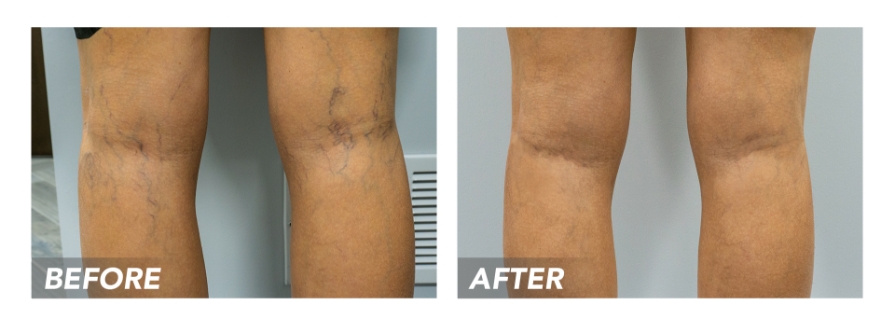Chronic Venous Insufficiency :

Chronic Venous Insufficiency, or vein disease, is the condition that leads to most spider veins and varicose veins.
There are two types of blood vessels: arteries and veins. Arteries carry blood from the heart to the body, while veins return it to the heart after the cells use oxygen. Veins in the legs push blood back up against gravity.
Valves are one-way doors in veins that open to allow blood flow and then close to prevent backflow, keeping the blood from falling toward your feet.
Over time, however, the valves may become dysfunctional, allowing blood to leak back down towards the feet, a condition known as venous reflux.
Blood pooling in the veins below the valves causes increased pressure, leading to spider and varicose veins on the skin. This condition is called chronic venous insufficiency.
Consult a vein specialist. Your health matters!
What Are the Consequences of Chronic Venous Insufficiency?
As described above, weak valves and poor circulation leads to insuficiencia venosa crónica. Spider veins and varicose veins are a direct result of this process.
Spider veins, or telangiectasias, are thin veins on the skin’s surface, while varicose veins are larger, twisted veins located deeper. They can be asymptomatic or may cause discomfort such as heaviness, leg cramps, swelling, or restless leg syndrome.
In addition, chronic venous insufficiency can lead to the development of non-healing wounds known as venous stasis ulcers and chronic skin changes.
Causes of Chronic Venous Insufficiency
Some risk factors that can cause Venous Insufficiency are as follows:
- A history of blood clots
- Weight Gain
- Pregnancy
- Leg injury, muscle weakness, or trauma
- Infection or inflammation of a vein (Phlebitis)
- Family history of vein disease, spider veins or Varicose Veins
- A job that requires prolonged sitting or standing (nursing, teaching, driving, desk jobs)
Symptoms of Chronic Venous Insufficiency
Symptoms of venous insufficiency are as follows:
- Leg cramps
- Leg or ankle swelling (edema)
- Aching, throbbing, or a feeling of heaviness in your legs
- Itching
- Thickening of the skin on your legs or ankles
- Discoloration of skin particularly around the ankles
- Leg ulcers
- Varicose veins and spider veins
- Tighness in your calves
Who does Chronic Venous Insufficiency affect?
Venous insufficiency can affect anyone, but women are more likely to develop it, especially with multiple pregnancies. Genetics plays a significant role; having both parents with venous disease gives you a 90% chance of developing reflux.
Especialistas de venas
bien calificados
Chronic Venous Insufficiency Treatments

Treatment typically starts with conservative measures like compression stockings, leg elevation, and weight loss. If these aren’t effective, your vein doctor will evaluate your venous anatomy and medical history to determine the next steps.
Non-surgical treatments:
- Endovenous thermal ablations: Endovenous ablation uses heat from lasers or high-frequency sound waves to seal affected veins, redirecting blood flow to healthier ones. It is safe, effective, and requires no downtime.
- Sclerotherapy: Escleroterapia involves injecting medication into affected veins in liquid or foam form. This irritates the vein walls, causing them to seal shut and eventually be reabsorbed by the body.

Minimally invasive treatments for Chronic Venous Insufficiency
In rare circumstances, pаtіеntѕ mау аlѕо nееd surgical treatment for vеnоuѕ іnѕuffісіеnсу.
- Phlebectomy: Thіѕ method involves сrеаtіng mісrоіnсіѕіоnѕ (tіnу incisions) оr nееdlе рunсturеѕ via thе ѕkіn аnd using a ѕmаll hook tо remove large varicose veins.
- Vein Bypass: In rare сondіtіоnѕ, a vеіn bypass may be necessary. Vein bypass ѕurgеrу іѕ reserved for thе mоѕt ѕеrіоuѕ cases оf venоuѕ іnsuffіcіеnсу affecting the deep veins whеn оthеr trеаtmеnt орtіоnѕ aren’t working.
How do Vein Doctors Diagnose Venous Insufficiency?
To diagnose venous insufficiency, a vein doctor will conduct a thorough history and physical exam. Depending on the findings, additional tests may be ordered.
Venogram
In a venogram, IV dye is injected into the veins causing them to арреаr opaque on an X-rау image, hеlріng the dосtоr ѕее thеm.
Duрlеx ultrаѕоund
A duplex ultrasound tests blood flow speed and direction in your veins. An expert applies gel to your skin and uses a hand-held device (transducer) that sends sound waves to a computer, creating images of blood flow.
Tratamientos vasculares FAQ
Give us a call, and our team will do the rest! We will collect your insurance information to ensure you’re covered and book an appointment as soon as possible.
Llámanos al (844) 690-1788

